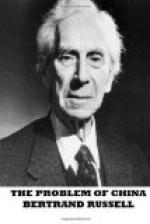After 645, the Mikado’s Government had real power for some centuries, but gradually it fell more and more under the sway of the soldiers. So long as it had wealth (which lasted long after it ceased to have power) it continued to represent what was most civilized in Japan: the study of Chinese literature, the patronage of art, and the attempt to preserve respect for something other than brute force. But the Court nobles (who remained throughout quite distinct from the military feudal chiefs) were so degenerate and feeble, so stereotyped and unprogressive, that it would have been quite impossible for the country to be governed by them and the system they represented. In this respect they differed greatly from the mediaeval Church, which no one could accuse of lack of vigour, although the vigour of the feudal aristocracy may have been even greater. Accordingly, while the Church in Europe usually defeated the secular princes, the exact opposite happened in Japan, where the Mikado and his Court sank into greater and greater contempt down to the time of the Restoration.
The Japanese have a curious passion for separating the real and the nominal Governments, leaving the show to the latter and the substance of power to the former. First the Emperors took to resigning in favour of their infant sons, and continuing to govern in reality, often from some monastery, where they had become monks. Then the Shogun, who represented the military power, became supreme, but still governed in the name of the Emperor. The word “Shogun” merely means “General”; the full title of the people whom we call “Shogun” is “Sei-i-Tai Shogun,” which means “Barbarian-subduing great General”; the barbarians in question being the Ainus, the Japanese aborigines. The first to hold this office in the form which it had at most times until the Restoration was Minamoto Yoritomo, on whom the title was conferred by the Mikado in 1192. But before long the Shogun became nearly as much of a figure-head as the Mikado. Custom confined the Shogunate to the Minamoto family, and the actual power was wielded by Regents in the name of the Shogun. This lasted until near the end of the sixteenth century, when it happened that Iyeyasu, the supreme military commander of his day, belonged to the Minamoto family, and was therefore able to assume the office of Shogun himself. He and his descendants held the office until it was abolished at the Restoration. The Restoration, however, did not put an end to the practice of a real Government behind the nominal one. The Prime Minister and his Cabinet are presented to the world as the Japanese Government, but the real Government is the Genro, or Elder Statesmen, and their successors, of whom I shall have more to say in the next chapter.




